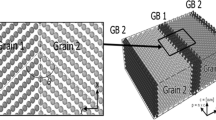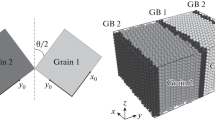Using the method of molecular dynamics, an investigation of the free volume and energy distribution is performed in the region of triple junctions of high-angle tilt boundaries with the <100> and <111> misorientation axes in nickel formed as a result of recrystallization. Crystallization is simulated from three crystalline nuclei for the varied free volume value. It is shown that during recrystallization the free volume is mainly concentrated in the region of grain boundaries and its fraction increases on approaching the grain-boundary junction. From the effective energy distribution in the region of triple junctions, their effective radius is determined. In the <100> tilt boundaries and their junctions, the free volume during recrystallization is dispersed more effectively that it is in the junctions formed by the <111> boundaries. For this reason, the energy radius of the triple junction of the <100> boundaries hardly varies with an introduction of a free volume: from 5 to 7 Å, while that of the junction of the <111> boundaries upon introduction of 2% vacancies into the initial computational cell becomes as large 14 Å.
Similar content being viewed by others
References
G. Palumbo and K. T. Aust, Scripta Metallurg. Mater., 24, 1771–1776 (1990).
M. Wegner, J. Leuthold, M. Peterlechner, et al., J. Appl. Phys., 116, 093514 (2014).
M. Yu. Gutkin and I. A. Ovidko, Usp. Mekh., No. 1, 68–125 (2003).
P. Rodriguez, D. Sundararaman, R. Divakar, and V. S. Raghunathan, Chemistry for Sustainable Development, 8, 69–72 (2000).
T. Frolov and Y. Mishin, Phys. Rev. B, 79, 174110 (2009).
I. Adlakha and K. N. Solanki, Sci. Rep., 5, 8692 (2015).
G. M. Poletaev, D. V. Dmitrienko, V. V. Diabdenkov, et al., Phys. Solid State, 55, No. 9, 1920–1924 (2013).
G. M. Poletaev, D. V. Novoselova, and V. M. Kaygorodova, Solid State Phenom., 249, 3–8 (2016).
G. M. Poletaev, D. V. Novoselova, I. V. Zorya, and M. D. Starostenkov, Phys. Solid State, 60, No. 5, 847–851 (2018).
F. Cleri and V. Rosato, Phys. Rev. B, 48, No. 1, 22–33 (1993).
N. A. Kalabukhova, G. M. Poletaev, M. D. Starostenkov, et al., Russ. Phys. J., 54, No. 12, 1394–1400 (2012).
G. M. Poletaev, I. V. Zorya, M. D. Starostenkov,et al., Russ. Phys. J., 61, No. 7, 1236–1240 (2018).
G. Poletaev, I. Zorya, andR. Rakitin, Computat. Mater. Sci., 148, 184–189 (2018).
G. M. Poletaev, I. V. Zorya, M. D. Starostenkov, et al., JETP, J. Exp. Theor. Phys., 128, No. 1, 88–93 (2019).
G. M. Poletaev, D. V. Dmitrienko, and M. D. Starostenkov, Fund. Proble. Sovr. Materialoved., 9, No. 3, 344–348 (2012).
M. A. Fortes andA. M. Deus, Mater. Sci. Forum., 455–456, 648–652 (2004).
O. B. Perevalova, E. V. Konovalova, Koneva, and E. V. Kozlov, J. Mater. Sci. Technol., 19, No. 6, 593–596 (2003).
C. C. Yang, A. D. Rollett, and W. W. Mullins, Scripta Mater., 44, 2735–2740 (2001).
Author information
Authors and Affiliations
Corresponding author
Additional information
Translated from Izvestiya Vysshikh Uchebnykh Zavedenii, Fizika, No. 4, pp. 109–114, April, 2019.
Rights and permissions
About this article
Cite this article
Poletaev, G.M., Starostenkov, M.D., Rakitin, R.Y. et al. Determination of the Radius of Triple Junctions of Tilt Boundaries: A Molecular Dynamics Simulation. Russ Phys J 62, 680–686 (2019). https://doi.org/10.1007/s11182-019-01763-3
Received:
Published:
Issue Date:
DOI: https://doi.org/10.1007/s11182-019-01763-3




